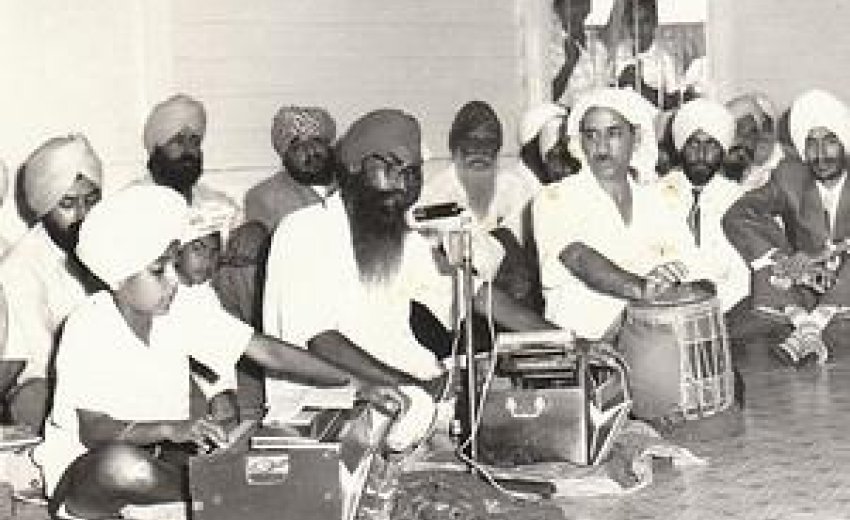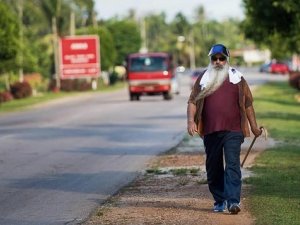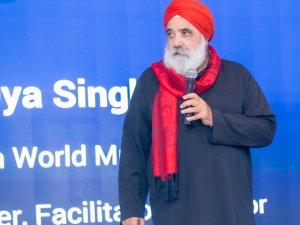I miss the Good Ol’ Days
Seeing the state of the practice of our faith and ‘way of life’, Sikhi today, brings back nostalgic memories of yesteryear (my childhood) when it seemed all so simple and full of joy. I speak of Sikhi in the former Malaya (now Malaysia) where I was born.
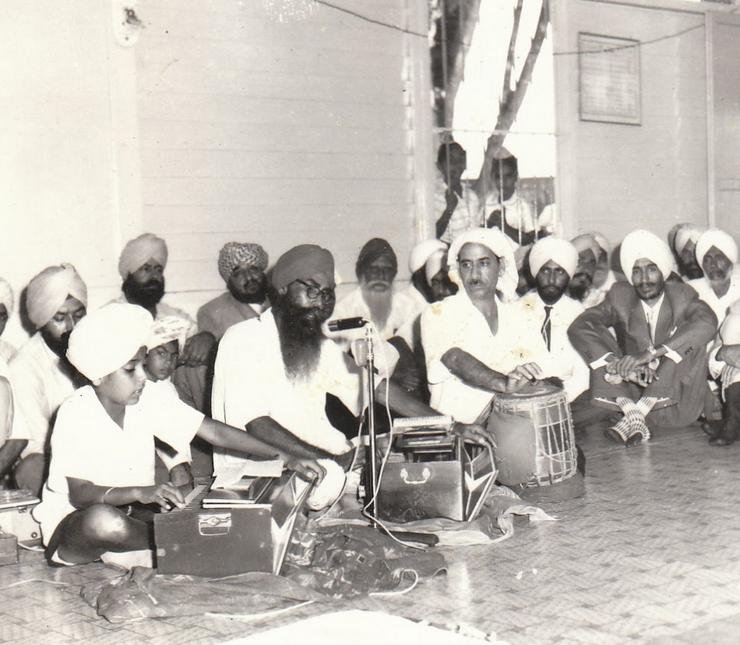
Dya Singh as a 10 yr. old assisting his father Giani
harchand Singh Ji to conduct an
Anand Karaj in 1960's Malaysia. Tabla by Moti
Ram Ji.
Today, professional granthis, raagis, kethakars and Percharaks come
and go, with very little rapport with the sangat. No granthi goes house
to house to ensure that all is well – assisting in any way he can if any
Sikh household was in need of spiritual sustenance beyond the
attendance of gurdwara. They used to, in those days. If someone in the
community was missing for a number of weeks from gurdwara, Bhai Sahib
or Giani Ji, either sent someone or went himself, to investigate. Kirtan
in services was normally done by Bhai Sahib with the help of sangat
members. Most sangat members could participate in kirtan. Many used to
learn from Bhai Sahib. Gurdwara goers used to frequent the gurdwara to
consult Bhai Sahib or just drop in for a chat and perhaps a cup of cha.
He was always there for advice or just a chat.
Finally, Bhai Sahib/Giani Ji used to be a consultant to the
committee, not their servant. He was a Babay-Dha-Vijir (Representative
of the Guru), and qualified for that title. I have witnessed a gurdwara
committee in Malaysia which gets their granthi to make ‘cha’ for them
whenever they have a committee meeting!
Yes, communities were small and everyone knew everyone. There was
community spirit and there was help from each other in times of need.
Everyone considered it their duty to come to do sewa – every kind of
sewa including the making of langgar and cleaning the toilets.
Everyone came to ‘metha-tek’ before going on to work or school.
Gurdwaras were made of wood and most raised one storey high – in most
towns in Malaysia as a precaution against floods. The ground floor used
to be the langgar area. There was no fuss about sitting on long benches
and eating langgar on long tables. These days, (since the ill
thought-out HukmNama of eating langgar sitting cross-legged on the
ground), eating langgar sitting on tables and chairs is frowned upon.
Gurdwaras were simple and felt homely. There was harmony in the
sangat/community. There was great love for the Guru and His teachings.
There is a saying in Malaysia – When the gurdwaras were ‘kechay’, Sikhi
was peki. Now gurdwaras are pekay, Sikhi has become kechee’.

Sangat in front of old style gurdwara - Taiping, Malaya Circa 1955
Langgar was simple - Rotian and dhal with sometimes the luxury of a
‘sabzi’. Salad (cucumbers, onion and tomatoes) was a rarity and we
delightfully called it ‘dhil khush’, or else there were always pickles
(achar), or as we called it jokingly – ‘dhil dukh’! There was of course,
always – ‘cha’, the national drink of gurdwaras. Rice, besides ‘rotian’
came later when I was much older. ‘Kheer’ was for very special
occasions. The same food cooked at home never ever tasted the same!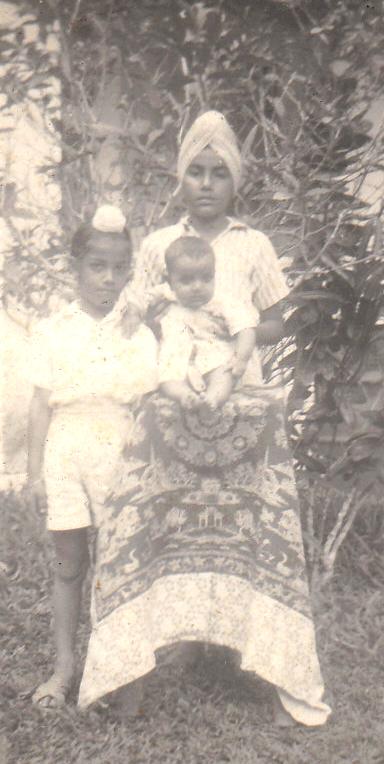 These
days, langgar is generally cooked by hired help or paid sewadhars, or
catered. Luckily, there are gurdwaras where the old practices are still
in vogue. Yes, times have changed. Maybe because I am no more a kid, but
the old spirit that used to exist in sangats and in gurdwaras does not
exist the way it used to. One feels a sense of indifference in sangats.
Granthis thought nothing of telling off those who used to talk to each
other in sangat, or children making noise or being a nuisance. Children
knew how to obey. Today, he would probably get his marching orders if he
tried!
These
days, langgar is generally cooked by hired help or paid sewadhars, or
catered. Luckily, there are gurdwaras where the old practices are still
in vogue. Yes, times have changed. Maybe because I am no more a kid, but
the old spirit that used to exist in sangats and in gurdwaras does not
exist the way it used to. One feels a sense of indifference in sangats.
Granthis thought nothing of telling off those who used to talk to each
other in sangat, or children making noise or being a nuisance. Children
knew how to obey. Today, he would probably get his marching orders if he
tried!
I miss my father, Giani Harchand Singh ‘Bassian’ – probably the
first government paid Punjabi school teacher in Malaya. He encouraged me
to do kirtan and never stopped me if I experimented with old Hindi
movie melodies but instead guided me in picking those melodies which
were raag based and suitable for gurbani or helped me in modifying them
to the spirit of the shabad, or even select the right shabad. In the
early days, he even took me to see Hindi movies and discuss them
afterwards, remembering that I stayed in gurdwara premises in my young
days.
He never burdened me with hours of ‘paath’ but encouraged me in
minimal but mindful discipline like doing JapJi Sahib in the morning
(mainly on the run as I was always late!), Rehras at dusk before dinner
and Sohila before sleeping. For him, Naam Simran was a 24 hours a day
exercise – a greater awareness of the present moment; a sense of
gratitude for all that had been bestowed upon me including this
beautiful life, and His constant presence.
He also encouraged me to do Babay-dha-Paath as it was called those days.
Yes, sangat members still did get the granthis to do sehaj paath for
them, but there were those who used to set aside time to come and listen
to path or even do ‘paath’. I used to do the odd hour of path whenever I
could.
It meant some leeway from my dad when I wanted to go for
a movie
or go out to meet friends!
Dya Singh the baby with older brother
Cnclr. Baldev Singh
and
Pr. Gurmukh Singh. Circa 1952.
(See current color pic. at bottom.)

Malayan granthis doing exercise at a Granthi conference in
K. Lipis (1952).
Dya Singh's father, Giani Harchand Singh is on the back row on
extreme left as you look at picture.
He encouraged me in physical fitness and liked me to join him in any gurdwara of other activities he was involved in – even Granthi Samelans which were held annually. Granthis used to get together for discourses and standardising practices in gurdwaras. And they used to be fun! Have you seen a granthi tug-of-war and other sports? I have! Granthi Samelans also had elements of physical activities. I have participated in a Granthis 100m. dash. Granthi Samelans generally used to take place in Malacca where Sant Baba Sohan Singh Ji was based.
No, we were not vegetarians. Bebe Ji cooked a mean chicken or ‘bakra’
curry and that was in gurdwara premises. There was no fuss about meat
eating and becoming vegetarians as a Sikh religious practice until after
I left Malaysia – which was in the early 70’s.
I miss our affectionate Sant Baba Sohan Singh Ji who was revered not
only by Malayan sangat but also all the granthis in Malaya then.
Firstly these crop of granthis were highly conversant with gurmatt and
most had ‘Giani’ qualifications. One, Giani Inder Singh Ji (of Sentul)
was even qualified enough and affiliated to a Punjabi university in
India, to offer ‘Giani’ classes in Malaya! In fact, if I am not
mistaken, my father completed his ‘Giani’ qualification through him!
Granthis were not afraid to further their ‘education’ in Sikhi!

(Kirtan by teenager Dya Singh & Bapu ji playing Tabla) 7.09.1976
Sant Baba Sohan Singh Ji played a monumental part in the ‘spirit’ of
Sikhi which existed in Malaya in the 1940’s through the 50’s, 60’s and
into the 70’s. He engineered Granthi Samelans so that all granthis had
consistent practices in all gurdwaras in Malaya/Malaysia and the sangat
was nurtured well in Sikhi principles. Even complaints against granthis
and complaints against gurdwara committees were aired at these
gatherings and resolved. He also initiated Sikh youth ‘samelans’ from
the 1950’s and played a pivotal role in the establishment of the Sikh
Naujawan Sabha Malaysia.
I was privileged in sometimes joining the travelling ‘jatha’ led by
Baba Ji doing Sikhi ‘perchar’ tours through the length and breadth of
peninsula Malaysia and Singapore in the 1960’s during my school
holidays. Bapu Ji used to do the kirtan. I used to join him and Baba Ji
used to do perchar. Gurdwaras, even in small towns, used to be packed
when we came. For me it was the opportunity of travelling and seeing
Malaya.
The odd jatha from India used to be of very high calibre. I remember
legendary jathas like Bhai Gopal Singh Ji, Bhai Angadh Singh Ji, Bhain
Tilli Bhai, Sant Raine Dhadhi Jatha. There was a constantly travelling
missionary called Giani Phuman Singh Ji – a very learned percharak.
There was close comraderie amongst all granthis as they used to get
together regularly at samelans and other events. They were always
upgrading themselves in Sikhi for the benefit of their sangats.
These days, rather light-weight jathas travel the world and just
because they are from India does not guarantee that they are going to
present something meaningful or significant. In fact, in more cases the
local jatha is probably better than the visiting jathas!
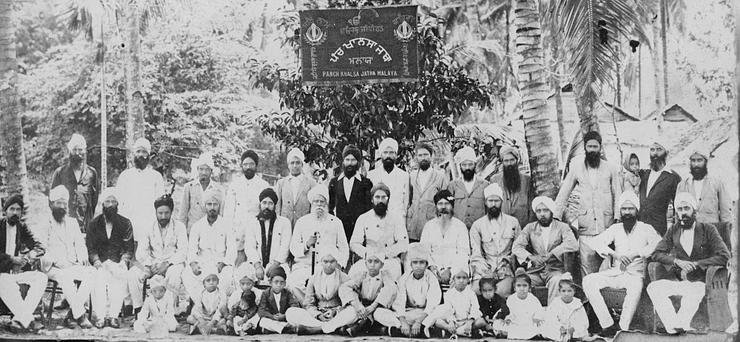
The new crop of granthis generally appear to be more like mercenaries
looking for more pay and benefits rather than thinking about the welfare
of their sangat. They quickly work out the ‘politics’ of their sangat,
and manipulate committees and sangat members to their benefit. In many
cases, they can’t be blamed because these days ‘granthi’ is a
profession, not a life of dedicated service to the ‘Guru’ and sangat.
Granthies want to make as much as they can in the shortest possible time
so that they could go back to India and build ‘kothies’ and have a
comfortable retirement. The ‘maya’ factor has become much stronger these
days.
I remember granthis at granthi Samelans discussing the possibilities
of unmarried granthis settling for less income so that ‘married’
granthis and their families could be paid more to look after their
families! These older crop of granthis were there to stay and dedicated
themselves to their sangat. All of them stayed and finally passed away,
in Malaysia.

The partaking of ‘amrit’ was also very different.
Amrit was partaken if one wanted to get married because couples who
wanted to go through the Anand Karaj ceremony were expected to be
‘amritdhari’ or told to take ‘amrit’ at the first opportunity. It was
more a rite of passage into adulthood rather than the cultish aspect it
has now evolved into.
I remember my own ‘amrit sanchar’ very well. Bapu Ji took me to see
Baba Sohan Singh Ji to discuss amrit as I had felt I was not ready for
it. I was 15 and a favourite of Baba Ji as I did kirtan and accompanied
Baba Ji and Bapu Ji on numerous occasions.
The conversation went something like this.
Baba Ji: Beta, your Bapu Ji tells me that you feel you are not ready for ‘amrit’
Me: Baba Ji, I will not be able to handle all the expectations of ‘amrit’ just yet.
Baba Ji: Chal beta. Let us go through all your apprehensions.
Me: I will not be able to do all the Nitnem banis expected of me.
Baba Ji: Can you do JapJi in the morning, Rehras at dusk and Sohila at night?
Me: I already do those.
Baba Ji: Well, we have no problem. As time goes by add Jaap Sahib
and Sawayiyay as Nitnem. Occasionally do the full Anand Sahib. In fact
you will find that doing Sukhmani Sahib occasionally is also very
uplifting. It will help you in your studies and even in your sports! Can
we agree on that?
Me: yes, Baba Ji.
Baba Ji: You know what is expected of you and let me assure you that
you will get supreme bliss and a sense of well-being every time you do
all the banis! Next?
Me: Baba Ji, 5 kekar. I cannot keep all 5 kekar on my person all the
time. I love my sports and cannot be lugging around a kirpan, a
kachhera and even a kanga in my hair. In fact when I play hockey, I am
even expected to take my kara off as it can hurt an opponent.
Baba Ji: Beta, I have one important question for you. Do you have intentions of cutting your hair into the future?
Me: (I was shocked at even being asked that). No Baba Ji, I shall always keep my hair. I am proud to be a Sikh!
Baba Ji: (Smiling, seeing the look of shock on my face.) Then Beta,
we have no problems. The other kekars are man-made. They can come off
and on as required. They are loving gifts from you bapu – Guru Gobind
Singh Ji. Treasure them. Keep them. In fact learn how to wield a kirpan
for defence and learn self-defence. Treasure your kachhera – do not go
chasing after loose women or any woman for that matter. Wear the kara as
your ornament from Guru Ji. Does that answer your question?
Me: Yes Baba Ji! But Baba Ji, I play team sports where I am expected to share drinks with other players. What about ‘jooth’?
Baba Ji: Not a problem. Let me explain something about amrit, beta.
Amrit once taken is not easily broken. Once your pita, dhan dhan Guru
Gobind Singh Ji Maharaj takes you by the arm, he does not easily give
you up! Amrit only breaks if you commit a heinous sin including cutting
your hair, engaging in extra-marital sex, eating halaal meat or
consuming tobacco – the four ‘bejer-kurahits’. You will come up short
many times as you are a human being. But all you have to do is realise
your shortcoming, pick yourself up, ask for forgiveness from your father
and move on in life. THAT IS AMRIT. Amrit is to give you a sense of
belonging – belonging to the family of Guru Gobind Singh. If you want to
be part of that family, then take amrit. It is as simple as that.
I saw no possible reason not to partake of amrit. It was more about
partaking of it and working with it rather than working at it first and
then partaking of it when one felt ready. Let me assure you, I believe
95 percent of youngsters or just Sikhs who would otherwise take amrit
will never ever feel ‘ready’ to partake of it. IF I HAD BEEN GIVEN A
CHOICE BY SANT BABA SOHAN SINGH JI, I THINK I WOULD NEVER HAVE GOT
AROUND TO PARTAKING OF AMRIT. He made the partaking of amrit feel like a
rite of passage into adulthood rather than an option of getting into a
rigid code of conduct for the rest of my life. Yes, I have fallen short
many times but I have never felt that it has ever been broken. I belong
to the family of Guru Gobind Singh Ji Maharaj.
I do not think I could go through today’s amrit because it appears
more like a prison sentence instead of making one feel liberated. I have
seen amritdharies lining up to partake of amrit again because they had
to take their kirpans off and put them into their luggage when they took
air flights. I know of amritdharies keeping kangas in their pockets
because they have no hair to comb any more, and cannot keep the kanga in
their dastaars. I have known of amritdharies not going swimming or
learning how to swim because they cannot put on swimming trunks over
their oversize kachheras. I have seen amritdharies whose hair had to be
shaved partially (from the knees or from the chest for ECG’s etc.)
retaking amrit because of this necessary removal of hair. I see
‘amrit-giving’ punj pyaray representatives insisting on intending
amritdharies being strict vegetarianism when that was never an issue in
the past.
Do not get me wrong! I admire those strict amritdharies who keep a
rigid discipline – up to five banis in the morning besides Rehras and
Sohila; full 5 kekars on their person; strict vegetarians; some even sit
cross-legged on the floor to eat their food; etc. but I honestly cannot
see a majority of today’s Sikh youth even partaking of amrit with this
degree of rigidity. In my day almost all youth partook of amrit. Today,
unfortunately, amrit has taken on a cultish ‘feel’ and less and less
Sikh youth partake of it. Those who do, have the tendency of becoming
rather cultish themselves – like the Akhand Kirteni Jatha or end up
being followers of some ‘sant’. They also have a tendency of holding
themselves aloof from other Sikhs who, they perhaps feel, are not up to
their mark. I miss the ol’ days.
We all dressed in one way. We all wore colourful ‘pointi’ turbans
and all wore colourful shirts and trousers, except for the Bhai Sahibs
or Giani Jis who wore white dastaars and white kudta-pajamas. Now we
have those who belong to one cult or another – wearing round turbans or
turbans which look side to side and only in white or blue and wearing
medieval looking clothes. There are those to whom the ‘bana’ means bare
legs with long cholas. Others have tight pajamas under long ‘cholas’.
They only wear dark blue or white. This is all as prescribed by their
chosen ‘sant’ or mukhi. Again, let me reiterate, amongst them are some
very close friends of mine and some very sincere and humble Sikhs. But, I
miss the simpleness of the good ol’ days.
Nostalgic – yes. I was a kid then and today we live in a global
village, but I certainly miss those idyllic good ol’ days in
pre-Malaysian Malaya. Guys rode to gurdwara on bicycles. Sangat members
used to come to gurdwara on public buses. Cars were rare and belonged
only to the rich. Punjabi class was vibrant and all Sikh kids attended
without exceptions. We played football and hockey in gurdwara fields or
fields attached to gurdwaras. We drank water from gurdwara taps and we
used to crack jokes with the granthis – they were our friends. Some even
stocked soft drinks from their own income for us! Sundays were special
because we all went to gurdwara and did sewa and kirtan, ate langgar and
eyed the pretty girls! Yes, life was good and Sikhi was a part of us.
Today it seems more about practising Sikhi rather than just being a
Sikh. It is a changing world and perhaps I am growing old and just being
nostalgic!
Dya Singh
Thank you to Bhaiji for the loan of the photos. Along with many
more, the photos you see here can be seen enlarged with much greater
detail on his very interesting blogspot: http://sewauk.blogspot.com.au

Baldev
Singh is without turban and Pr. Gurmukh Singh on the right.
Dya Singh is in the
middle with their mother on his right and
their older sister on his left.

